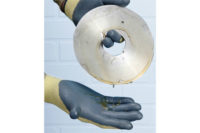Disposable gloves

A generation ago U.S. workers were just beginning to understand the importance of single-use, disposable gloves. Today’s health care professionals wouldn’t consider anything but single-use disposable glove protocols. All bodily fluids are presumed to be contaminated, and as a result, disposable gloves have ventured far beyond the health care environment.
Controlling communicable disease
The control of certain communicable diseases is testament to the effectiveness of glove wearing, especially when combined with hand washing. Infectious disease threats continue to emerge, however, and old problems linger.
In their combined report, “Health, United States, 2009,” the Centers for Disease Control and Prevention, the National Center for Statistics, and the U.S. Department of Health and Human Services note that, “The number of new cases of many infectious diseases, such as measles and rubella, has decreased greatly as a result of vaccination and other prevention initiatives. However, incidence rates of some communicable diseases, including chlamydia, have increased. In addition, newly recognized infectious agents have emerged and caused substantial public health concern and investment. These include influenza H1N1, SARS, H5N1 avian influenza, and some particularly virulent or drug-resistant bacterial strains, such as Methicillin- Resistant Staphylococcus aureus (MRSA).”
Fast-paced history
Due to the simplicity of the technology and the product’s exceptional performance, protective gloves were originally made of natural rubber latex (NRL). It wasn’t until the 1980’s threat of HIV, however, that disposable glove wearing proliferated.
Because of allergic reactions, the need for glove materials other than latex soon became apparent. OSHA’s estimates of the number of people allergic to latex range from 6 to 17 percent of the population with the majority suffering from contact dermatitis. A second type of allergic reaction can occur with latex gloves manufactured with certain chemicals. The most serious type of allergic reaction, however, occurs in only about one percent of the cases; this reaction can compromise the body’s immune system. Because of these risks, disposable gloves are produced in both latex and latexfree materials such as nitrile and vinyl.
Present-day technology produces hi-tech gloves that safeguard users against biological warfare as well as against bacterial and viral contamination. Increasing global demand for medical, household and other purpose disposable gloves is driven by an increasing population and by a rising emphasis on health, occupational safety and hygiene among end-users including individual consumers and the food, medical, dental and service industries.
Evaluate your workplace
Employers who have never thought about the need for disposable gloves are asking questions such as: Who in my organization is likely to need disposable hand protection? Which employees share phones, computers and office equipment? Who continually interacts with the public or regularly handles items from unknown sources?
These questions must be answered in order to determine the best safety practices for your organization. These might include equipping the mail room with disposable gloves, placing disposable gloves in all company restrooms, giving janitorial staff disposable gloves in addition to the reusable gloves they already have, making disposable gloves readily available to reception and security personnel and making all employees aware of where they can access disposable gloves when needed.
Although few employees face the day-to-day challenges faced by law enforcement officers, their standards offer a good guide for those who do face possible exposure. A summary of the University of Texas at Austin Police Department guidelines includes the following:
Officers will:
- Carry protective gloves while on duty.
- Ensure that gloves are not torn prior to use — rings, jewelry or long fingernails may compromise the glove’s strength.
- Properly dispose of used gloves.
- Not leave gloves at the scene of a call or arrest.
- Use gloves when: searching arrested persons; searching vehicles (to avoid being stuck with hypodermic needles and other dangerous objects); handling, packaging or transporting items that may contain blood or bodily fluids; administering first aid to injured persons when there is a risk of exposure to blood or body fluids; cleaning areas contaminated by blood spills or bodily fluid.
- Wash their hands after using gloves.
- Not re-use gloves.
Before purchasing any glove, whether it is manufactured using latex, vinyl or Nitrile, companies must assess a few factors:
- What amount of protection will employees need?
- Are any employees allergic to any glove materials?
- What is the quality of the glove?
- Do you prefer powdered or unpowdered gloves?
- How comfortable is the glove?
- What size gloves are needed?
- Medical grade offers the highest grade of protection; they must surpass FDA requirements and exceed a broad range of specifications.
- High-risk gloves meet the high levels of testing required for use in the emergency medical services fields.
- Utility grade, normally used for painting and general hand protection, are manufactured to American Society for Testing and Materials (ASTM) specifications.
- Latex gloves offer flexibility, comfort and fit. They are still the most popular but are accompanied by the risk of latex allergy.
- Vinyl disposable gloves are inexpensive and latexfree. They offer standard barrier protection and are made from polyvinyl chloride (PVC). They are great for resistance against liquids but should not be used in high-risk environments,
- Nitrile disposable gloves eliminate the risk of latex allergy while offering excellent durability, strength and tactile sensitivity. Widely regarded as the optimal alternative to latex gloves, they are manufactured using synthetic latex, contain no latex proteins and are three times more puncture-resistant than natural rubber.
Disposable gloves have earned a permanent place in the American workplace, and every year more and more employers are adding them to their safety programs. Isn’t it time you discovered where disposable gloves fit into your workplace?
Looking for a reprint of this article?
From high-res PDFs to custom plaques, order your copy today!




